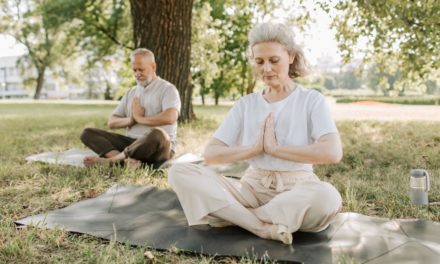By Rita La Rosa Loud, B.S.
Certain older adults are blessed with good health, but often take their state of affairs for granted. Then there are those less fortunate who are resigned to the card(s) they have been dealt in life. Whether we have been lucky enough to have been bestowed with good health or not, it behooves us to take charge of it, for as the saying goes, “health is wealth.”
Understandably, life challenges can get in the way of dealing with health concerns. Yet, in spite of this, we can restore and enhance our physical well-being. So, why not start today?
Although my mom was apparently active as a young girl as seen in old photos of her in fencing gear, she was very sedentary as an adult. She was not unlike 70 percent of adult men and women in the U.S. who suffer with life threatening health issues due to an inactive lifestyle, e.g., high blood pressure, cardiovascular disease, stroke, obesity, and diabetes, and I lost her to heart disease. This was the impetus for me to promote all forms of physical activity, particularly resistance exercise, to everyone of all ages. Indeed, if mom were alive today, I would encourage her to participate in a fitness program of strength training, aerobic exercise, and stretching.
Although there are many health conditions that we could either prevent, reduce, or improve upon with diet and exercise, I would like to address three common health disorders (high blood pressure, osteoporosis, and diabetes), that have proven health benefits associated with a comprehensive fitness program. First, a couple of important fitness facts you should know.
FITNESS FACT ONE Older adults and seniors who do not participate in strength training on a consistent basis, lose approximately 10 percent of their lean muscle every 10 years, which amounts to 5 to 10 pounds per decade. This loss of active tissue leads to a condition known as sarcopenia, which results in weakening of the musculoskeletal system (muscle, tendons, ligaments, and bones).
FITNESS FACT TWO Older adults and seniors who do not engage in regular resistance training, lose 30 percent bone mineral density per decade; that is 1 percent to 3 percent per year, which leads to less dense bones that are associated with undesirable medical conditions such as osteopenia, osteoporosis and increased risk of falls and bone fractures.
EVIDENCED-BASED HEALTH STUDIES
The following are select evidence-based blood pressure, bone density, and blood sugar studies.
Blood Pressure Studies
According to Kelley and Kelley 2000 meta-analysis, resting blood pressure readings were reduced when partaking in strength training. In a nine-month study combining 20 minutes of strength training and 20 minutes of aerobic exercise, resting blood pressure significantly lowered by 10 mmHg systolic and 5 mmHg diastolic, Westcott et al. 2011. It appears that resistance training is just as effective as aerobic activity for reducing blood pressure. Researchers concur that the most effective means for improving resting blood pressure is a combination of aerobic exercise and resistance exercise.
Bone Density Studies
Research shows substantial gains in bone mineral density after participation in resistance training. Moreover, nutritional supplementation of protein, calcium, and Vitamin D with resistance exercise has a positive effect on bone mineral density. In a nine-month Westcott et al. 2011 study, older adults and seniors who strength trained and consumed protein, calcium, and Vitamin D supplements increased bone mineral density by 1 percent. The subjects who strength trained without the nutritional factors, maintained their bone mineral density, while subjects who did not strength train or ingest nutritional supplements decreased their bone mineral density by 1 percent. Consistent with Gut and Kasper 1992, strength training and weight-bearing exercise are more productive than aerobic exercise alone for enhancing bone mineral density.
Blood Sugar Studies
Boyle’s 2020 research indicates that due to a sedentary lifestyle associated with muscle loss and coupled with fat gain, approximately 30 percent of adult Americans will, unfortunately, develop diabetes by the year 2050. As muscle is a primary locale for glucose storage and utilization in our bodies, loss of muscle tissue triggers the probability of glucose intolerance and an increased risk of diabetes, Flack et al. 2011. According to Campbell et al. 1994; Pratley et al. 1994, resistance exercise is the best means for increasing muscle tissue and muscle metabolism.
In Quincy College’s Westcott, et al. 2017 study, senior subjects made significant improvements in HbA1c (blood sugar) readings subsequent to strength training on nine fundamental resistance machines, two times per week for three months. This research was conducted in accordance with the American Diabetes Association’s 2016 Position Statement, which highly recommended strength training to control Type 2 diabetes. Hence, resistance exercise is an efficient method for increasing muscle mass, reducing body fat, and ultimately reducing blood sugar levels.
Wayne Westcott, Ph.D. Center for Health and Fitness at Quincy College
If you would like to become physically active today and address health conditions you may be experiencing, please consider the Wayne Westcott, Ph.D. Center for Health and Fitness at Quincy College. We are located at President’s Place, 1250 Hancock Street, Quincy, across from the T-Station. Call Rita at 617.405.5978 to schedule a tour, free training session, or to learn more about our registration process. Free 1- 2-hour parking is available on Hancock, Washington, Coddington Streets plus a parking garage is next to the building for a nominal fee.
Rita La Rosa Loud holds a B.S. in Exercise Physiology with additional education in Sports Medicine and Athletic Training. She is NASM Certified; has been actively involved in the fitness industry for over 35 years. She is an author and writes fitness related articles for various fitness publications. Rita is a Fitness Researcher and Directs the COVID compliant, Wayne Westcott, Ph.D. Center for Health and Fitness at Quincy College. She can be reached at 617.405.5978 and is available for speaking engagements.



